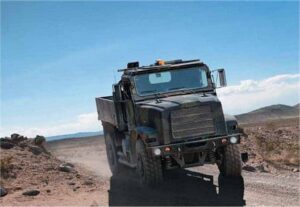Unmanned tactical wheeled vehicles that have the potential to serve as a force multiplier and reduce Warfighters’ exposure to lethal attacks continue to come closer to reality. The U.S. Marine Corps Warfighting Lab (MCWL) and Oshkosh Defense, a division of Oshkosh Corporation, recently conducted the Marines’ first-ever training of multiple unmanned ground vehicles (UGV) in a single convoy using the Oshkosh TerraMax™ UGV technology. The Marines then evaluated the UGVs to determine how they can be utilized to support real-world “dull, dirty and dangerous” missions.
These most recent developments are a continuation of the MCWL’s Cargo UGV initiative, which uses Oshkosh Medium Tactical Vehicle Replacements (MTVR) equipped with the TerraMax UGV technology, and took place during the MCWL’s Enhanced MAGTF Operations (EMO) Limited Objective Experiment (LOE) 2.2, July 24 through Aug. 5 at Fort Pickett, Va. The EMO LOE 2.2 sought to evaluate technologies and capabilities being developed for future missions.
“Seven Marines were trained on our UGVs’ operations in only three days at the EMO LOE 2.2,” said John Beck, chief unmanned systems engineer for Oshkosh Corporation. “That’s a testament to the TerraMax technology’s ease of control and user-friendly design. The capabilities of our highly sophisticated UGV systems require minimal user intervention to complete their missions – opening the door for future logistics operations to be conducted with fewer Warfighters, reducing cost and saving lives.”
Combat-veteran Marines were trained on the Oshkosh UGV technology for the first time in August 2011 and also assessed it in a series of tests in challenging terrain and environments. Following that successful evaluation, Oshkosh delivered a second TerraMax-equipped MTVR earlier this year, and in June the government evaluated two Oshkosh UGVs operating in concert with a manned command-and-control vehicle. Several key tasks were accomplished, including:
One operator supervised the operation of two unmanned MTVRs in convoy operations
Vehicles operated successfully in complete blackout mode during night operations with no degradation in performance.
Vehicles navigated a wide range of terrain, including deep sand trails, clay roads with encroaching vegetation, two-track trails overgrown with grass and narrow creek crossings, and adjusted speeds to maintain proper intra-vehicle spacing.



















